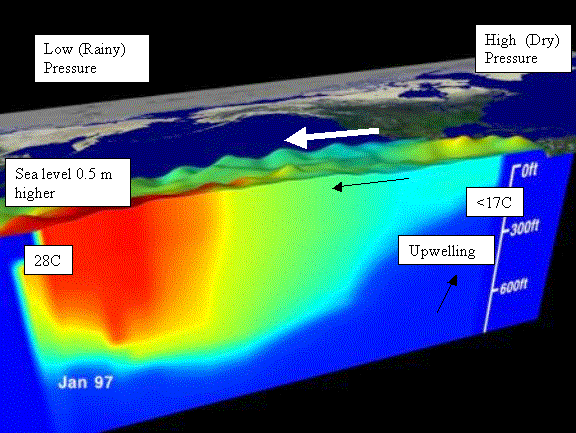 Red
is 30 degrees C and blue is 8 degrees C.
Red
is 30 degrees C and blue is 8 degrees C.El Nino Lab, Lab 8
This site should have been included as a reference:
http://www.pmel.noaa.gov/tao/elnino/el-nino-story.html
However, all of info could have been found given the handouts and other sites suggested.
2) El Nino is a disruption of the ocean-atmosphere system in the tropical Pacific which affects the larger atmospheric and ocean circulation patters resulting in a global phenomena.
Among these consequences are increased rainfall across the southern tier of the US and in Peru, which has caused destructive flooding, and drought in the West Pacific, sometimes associated with devastating brush fires in Australia.
3) During El Niņo, upwelling of cold waters along western South America is reduced and the supply of nutrient rich water to the euphotic zone is cut-off. The result is a rise in sea surface temperature and a drastic decline in primary productivity. Phytoplankton require nutrients to survive, grow, and reproduce. The decline in phytoplankton reduces the food source for zooplankton, which also decline and triggers a decline in resources up the food chain. Fish stocks drop due to both changes in temperature and food supplies. Higher trophic levels, represented by seabirds and marine mammals, are thus also negatively affected.
Normal Conditions
The sea surface temperature is about 8 degrees C higher in the west, with cool temperatures off South America, due to an upwelling of cold water from deeper levels. This cold water is nutrient-rich, supporting high levels of primary productivity, diverse marine ecosystems, and major fisheries. Rainfall is found in rising air over the warmest water, and the east Pacific is relatively dry. The observations at 110 W (left diagram of 110 W conditions) show that the cool water (below about 17 degrees C, the black band in these plots) is within 50m of the surface. In normal, non-El Niņo conditions (next page), the trade winds blow towards the west across the tropical Pacific. These winds pile up warm surface water in the west Pacific, so that the sea surface is about 1/2 meter higher at Indonesia than at Ecuador.
Normal Conditions
Note this figure shows only the top 600 ft (~200 m) of the sea where the thermocline typically is found. However the water depth may extend down to 4000-5000 m.
 Red
is 30 degrees C and blue is 8 degrees C.
Red
is 30 degrees C and blue is 8 degrees C.
El Nino
During El Niņo the trade winds relax in the central and western Pacific leading to a depression of the thermocline in the eastern Pacific, and an elevation of the thermocline in the west. Upwelling is dramatically decreased. The weakening of easterly tradewinds during El Niņo is evident. Rainfall follows the warm water eastward, with associated flooding in Peru and drought in Indonesia and Australia. The eastward displacement of the atmospheric heat source overlaying the warmest water results in large changes in the global atmospheric circulation, which in turn force changes in weather in regions far removed from the tropical Pacific.